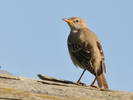search
classification
|
basic information
|
Rosy Starling
Sturnus roseus (Linnaeus, 1758)

|
 adult
|
|
|
2021-06-01
Altai Republic |
© Denis Zhbir
|
|
Description
The male of Rosy Starling in breeding plumage has black bluish-purple tinged head, neck, throat and front part of craw. The elongated feathers of the crown formed the crest. The scapulars, mantle, rump, breast and abdomen are rosy. The uppertail, undertail and feathers of the shank are black. The wings are black; the upper wing coverts and secondaries are with purple-green tone. The under wing coverts are black with rosy edges. The tail feathers are black. The bill is dichromatic; the base of lower mandible is black; other parts are rosy. The legs are yellow-brownish; the eyes are dark-brown. The female is dimmer; the crest is shorter. Juveniles have buffy-brownish upperparts; dirty buffy-white underparts; dark strikes on the throat. The flight and tail feathers are dark-brownish with the broad buffy or pale edges. Weight 59-89 grams, wing 116,1-133,3, tail 58,1-72,3 mm.
Biology
The Rosy Starling is common, in places numerous, breeding migrant. It inhabits the steppes, semi-deserts, low mountains up to 1300-1500 m (rare on 2300-2400 m) in the areas of largest congestion of locusts; therefore the breeding areas are varied from year to year. During the migration it also visits the vineyards, cherry gardens, pastures, reed beds and lake shores. In spring it arrives late. On the South Kazakhstan it arrives in the first half of May; in some years in the end of April; in the north parts of the range it arrives in the second half of May. It migrates in flocks up to two thousand birds. It breeds in colonies which formed only nearby the mass outbreak of locust larvae, which are very well notable in May. The Rosy Starling is very social bird and prefers to breed in the colonies of several thousands or even hundreds of thousands pairs (one colony contained 100000 pairs, near Dzhansugurov in Dzhungarskiy Alatau foothills). In groups of several tens pairs it nests very rare. The nest is built in cavities between the stones (prefer the larger rubble); in cracks or crevices in rock; in the crushed constructions, under the thatched roofs of sheep folds with the large number of the applicable to nesting places. The nest is built by both parents from the dry grass and is lined with thinner grass, often with some feathers and fresh sprigs of wormwood. The pairs are formed in the colony. The female sits in half-built nest, which is completed during the laying. Clutches of 4-8 (more often 4-6) eggs are laid in mid May – early July. Only female incubates during 15 days. Both parents feed juveniles; in searching of locust prey birds fly up to 20, even 75 km. Juveniles probably fledge at age 20-24 days, in early June – end July. The main food of the Rosy Starling is abundant species of locust. The very valuable character of this bird that even loaded bird doesn't cease to kill the locust; and not eating quit it. Birds synchronous leave the colonies abandoning the late nests with the eggs or juveniles. The autumn migration starts early and occurs in end July – August, last birds migrate till the end of September.
References













